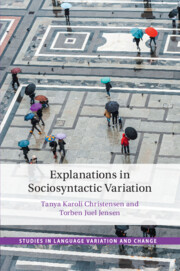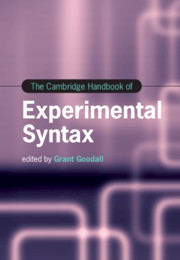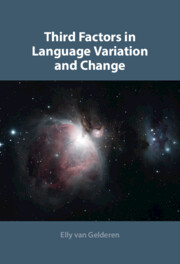Refine search
Actions for selected content:
6584 results in Grammar and Syntax
3 - A Columbia School Perspective on Explanation in Morphosyntactic Variation
-
-
- Book:
- Explanations in Sociosyntactic Variation
- Published online:
- 06 January 2022
- Print publication:
- 20 January 2022, pp 90-119
-
- Chapter
- Export citation
Contents
-
- Book:
- Explanations in Sociosyntactic Variation
- Published online:
- 06 January 2022
- Print publication:
- 20 January 2022, pp v-v
-
- Chapter
- Export citation
Series Editor’s Preface
-
- Book:
- Explanations in Sociosyntactic Variation
- Published online:
- 06 January 2022
- Print publication:
- 20 January 2022, pp xiii-xiv
-
- Chapter
- Export citation
6 - When Variants Lack Semantic Equivalence: Adverbial Subclause Word Order
-
-
- Book:
- Explanations in Sociosyntactic Variation
- Published online:
- 06 January 2022
- Print publication:
- 20 January 2022, pp 171-206
-
- Chapter
- Export citation
5 - The Predictability of Social Stratification of Syntactic Variants
-
-
- Book:
- Explanations in Sociosyntactic Variation
- Published online:
- 06 January 2022
- Print publication:
- 20 January 2022, pp 144-170
-
- Chapter
- Export citation
4 - On the Inevitability of Social Meaning and Ideology in Accounts of Syntactic Change: Evidence from Pronoun Competition in Netherlandic Dutch
-
-
- Book:
- Explanations in Sociosyntactic Variation
- Published online:
- 06 January 2022
- Print publication:
- 20 January 2022, pp 120-143
-
- Chapter
- Export citation

Explanations in Sociosyntactic Variation
-
- Published online:
- 06 January 2022
- Print publication:
- 20 January 2022

The Cambridge Handbook of Experimental Syntax
-
- Published online:
- 16 December 2021
- Print publication:
- 09 December 2021

Third Factors in Language Variation and Change
-
- Published online:
- 16 December 2021
- Print publication:
- 16 December 2021
2 - Labeling in Language Change
-
- Book:
- Third Factors in Language Variation and Change
- Published online:
- 16 December 2021
- Print publication:
- 16 December 2021, pp 29-61
-
- Chapter
- Export citation
Abbreviations
-
- Book:
- Third Factors in Language Variation and Change
- Published online:
- 16 December 2021
- Print publication:
- 16 December 2021, pp xiv-xvi
-
- Chapter
- Export citation
1 - The Shift towards a Minimal UG
-
- Book:
- Third Factors in Language Variation and Change
- Published online:
- 16 December 2021
- Print publication:
- 16 December 2021, pp 1-28
-
- Chapter
- Export citation
5 - Labeling and Determinacy: Verb-Second and Expletives
-
- Book:
- Third Factors in Language Variation and Change
- Published online:
- 16 December 2021
- Print publication:
- 16 December 2021, pp 123-158
-
- Chapter
- Export citation
3 - Determinacy in Language Variation
-
- Book:
- Third Factors in Language Variation and Change
- Published online:
- 16 December 2021
- Print publication:
- 16 December 2021, pp 62-86
-
- Chapter
- Export citation
7 - Conclusion
-
- Book:
- Third Factors in Language Variation and Change
- Published online:
- 16 December 2021
- Print publication:
- 16 December 2021, pp 198-199
-
- Chapter
- Export citation
4 - Determinacy in Language Change
-
- Book:
- Third Factors in Language Variation and Change
- Published online:
- 16 December 2021
- Print publication:
- 16 December 2021, pp 87-122
-
- Chapter
- Export citation
Figures
-
- Book:
- Third Factors in Language Variation and Change
- Published online:
- 16 December 2021
- Print publication:
- 16 December 2021, pp viii-viii
-
- Chapter
- Export citation
References
-
- Book:
- Third Factors in Language Variation and Change
- Published online:
- 16 December 2021
- Print publication:
- 16 December 2021, pp 200-218
-
- Chapter
- Export citation
Preface
-
- Book:
- Third Factors in Language Variation and Change
- Published online:
- 16 December 2021
- Print publication:
- 16 December 2021, pp xi-xiii
-
- Chapter
- Export citation
Index
-
- Book:
- Third Factors in Language Variation and Change
- Published online:
- 16 December 2021
- Print publication:
- 16 December 2021, pp 219-222
-
- Chapter
- Export citation
